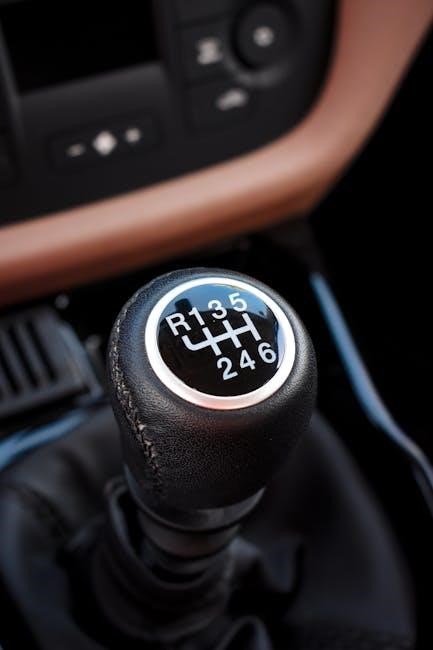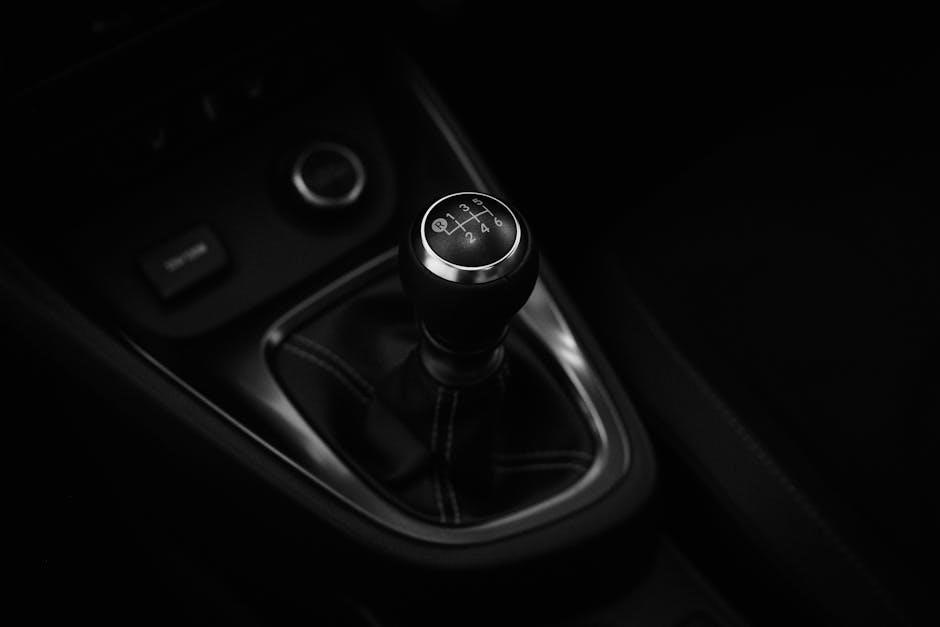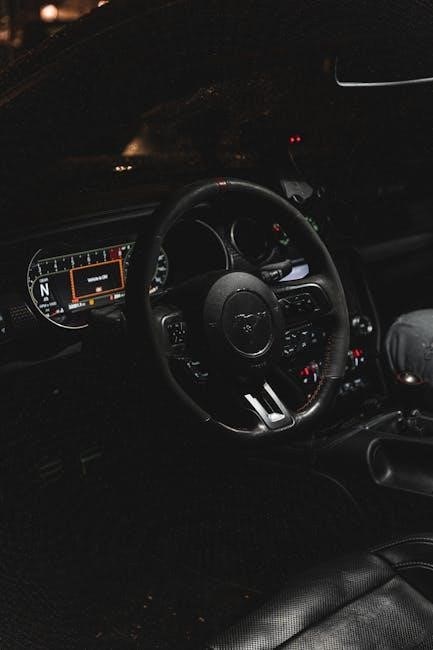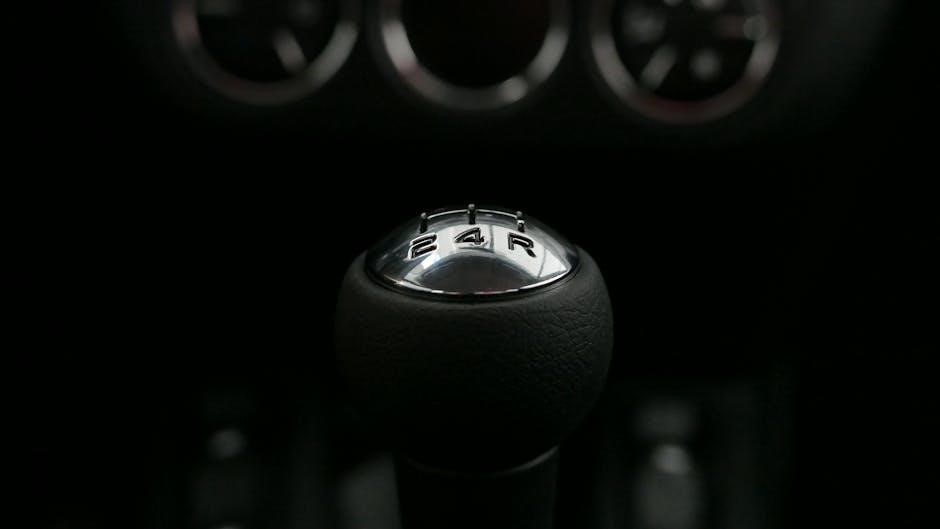Manual and CVT transmissions offer distinct driving experiences‚ with manual providing gear control and CVT offering seamless acceleration. This comparison explores their features‚ benefits‚ and drawbacks to help drivers make informed decisions.
What is a Manual Transmission?
A manual transmission‚ also known as a stick shift‚ is a type of gearbox that requires the driver to manually change gears using a clutch pedal and a gearshift. It operates by disconnecting the engine from the wheels via the clutch‚ allowing the driver to select the appropriate gear ratio for different driving conditions. Manual transmissions typically have 4 to 6 forward gears and one reverse gear‚ providing precise control over acceleration and speed. This system relies on the driver’s skill to coordinate pressing the clutch‚ shifting gears‚ and adjusting acceleration smoothly. The manual transmission is known for offering better fuel efficiency‚ lower production costs‚ and a more engaging driving experience compared to automatic or CVT transmissions. However‚ it requires practice to master and can be less convenient in heavy traffic or hilly terrain. Overall‚ manual transmissions are favored by drivers who enjoy a hands-on connection with their vehicle.
What is a CVT Transmission?
A Continuously Variable Transmission (CVT) is an automatic transmission system that uses pulleys and a belt or chain to provide an infinite number of gear ratios. Unlike manual or traditional automatic transmissions‚ a CVT does not have fixed gears; instead‚ it adjusts the ratio continuously to optimize engine performance and fuel efficiency. This allows the engine to operate at its most efficient RPM range‚ regardless of driving conditions. CVTs are designed to provide smooth‚ seamless acceleration without the noticeable “shifts” felt in other transmissions. They are often used in smaller vehicles or hybrid models to maximize fuel economy. The CVT’s operation is controlled electronically‚ ensuring optimal performance in various driving scenarios‚ from city traffic to highway cruising. While they offer advantages in efficiency and simplicity‚ CVTs can sometimes feel unnatural to drive due to their unique operation‚ which lacks the direct connection of a manual transmission or the distinct gear changes of an automatic.
Purpose of the Comparison
The purpose of this comparison is to provide a comprehensive understanding of manual and CVT transmissions‚ highlighting their differences in design‚ functionality‚ and performance. By examining their unique characteristics‚ pros‚ and cons‚ drivers can make informed decisions based on their specific needs‚ driving habits‚ and preferences. This comparison aims to clarify the advantages of manual transmissions‚ such as driver control and fuel efficiency‚ and the benefits of CVT transmissions‚ including seamless acceleration and reduced complexity. It also addresses factors like cost‚ reliability‚ and lifestyle considerations that influence transmission choice. Whether you prioritize performance‚ convenience‚ or budget‚ this guide offers insights to help you choose the most suitable transmission type for your vehicle and driving style.

Manual Transmission
A manual transmission‚ also known as a stick shift‚ allows drivers to manually change gears using a clutch pedal and gearshift. It offers precise control‚ better fuel efficiency‚ and a more engaging driving experience.
Definition and Operation
A manual transmission‚ often referred to as a stick shift‚ is a type of gearbox that requires the driver to manually change gears using a clutch pedal and a gearshift. The clutch pedal disengages the engine from the transmission‚ allowing the driver to shift gears without grinding. Once the desired gear is selected with the gearshift‚ the clutch pedal is released‚ reconnecting the engine to the transmission. Manual transmissions typically use a set of fixed gears‚ with the number varying depending on the vehicle‚ usually ranging from 4 to 6 or more.
The operation relies on the driver’s input to match the gear to the vehicle’s speed and load. For example‚ first gear is used for starting from a standstill‚ while higher gears are for cruising at higher speeds. The synchromesh mechanism ensures smooth shifting between gears‚ and the driver must press the clutch and move the gearshift to engage the desired gear. This system provides direct control over the vehicle’s power delivery‚ making it popular among driving enthusiasts. The manual transmission is known for its simplicity‚ efficiency‚ and cost-effectiveness compared to other types of transmissions.
Pros of Manual Transmission
Manual transmissions offer several advantages that make them a popular choice among drivers. One of the most significant benefits is better fuel efficiency‚ as manual transmissions typically consume less fuel compared to automatic or CVT transmissions‚ especially in city driving conditions. Additionally‚ manual transmissions provide greater control over the vehicle‚ allowing drivers to optimize acceleration and deceleration according to their preferences. This direct engagement enhances the driving experience‚ making it more enjoyable for enthusiasts. Another key advantage is the lower cost of purchase and maintenance; manual transmissions are generally cheaper to buy and repair than CVT or automatic transmissions. They are also simpler in design‚ which often translates to longer durability and reduced risk of mechanical failure. Furthermore‚ manual transmissions are lighter‚ which can improve overall vehicle performance and handling. These factors make manual transmissions a practical and satisfying option for many drivers.
Cons of Manual Transmission
Manual transmissions have some notable drawbacks. They require more driver engagement‚ as shifting gears manually can be tiring in heavy traffic and stressful for inexperienced drivers. The need for constant gear changes‚ especially in stop-and-go situations‚ can lead to driver fatigue over time. Additionally‚ the learning curve for mastering a manual transmission can be steep‚ discouraging some from opting for this type of gearbox. In hilly or steep terrains‚ manual transmissions can be less convenient due to the need for frequent shifting to maintain control and prevent rolling. Furthermore‚ with advancements in CVT and automatic transmissions‚ the convenience and ease of use they offer make manual transmissions less appealing for many drivers seeking a hassle-free experience.
Key Features of Manual Transmission
Manual transmissions are characterized by their mechanical simplicity and driver engagement. They typically feature a set number of gears‚ usually between 4 to 6‚ which the driver manually selects using a gearshift and clutch pedal. This setup allows for precise control over power delivery and torque‚ making it ideal for performance driving. The clutch pedal disengages the engine from the transmission‚ enabling smooth gear changes without automatic intervention. Manual transmissions are generally lighter and more fuel-efficient compared to automatics‚ contributing to better mileage and lower emissions. They are also more cost-effective in terms of purchase price and maintenance. Additionally‚ manual transmissions often come with a more connected driving experience‚ appealing to enthusiasts who enjoy the tactile nature of shifting gears. Overall‚ these features make manual transmissions a preferred choice for drivers seeking control‚ efficiency‚ and affordability.

CVT Transmission
CVT (Continuously Variable Transmission) uses pulleys and belts to provide infinite gear ratios‚ enabling smooth acceleration and optimal fuel efficiency. It’s ideal for city driving but can lack the engagement of manual transmissions.
A CVT (Continuously Variable Transmission) is a type of automatic transmission that uses a belt and pulley system to provide an infinite number of gear ratios. Unlike manual or traditional automatic transmissions‚ which have a fixed number of gears‚ a CVT adjusts the ratio dynamically to keep the engine operating within its most efficient RPM range. The system consists of two variable-diameter pulleys connected by a belt‚ which can move along the pulleys to change the effective gear ratio. This allows for smooth‚ seamless acceleration without the noticeable “shifts” of other transmissions. The operation is controlled by a computer that monitors driving conditions and adjusts the pulleys accordingly to optimize performance‚ fuel efficiency‚ or power delivery‚ depending on the situation. This design makes CVTs particularly well-suited for city driving or applications where frequent speed changes are required.
Pros of CVT Transmission
A CVT (Continuously Variable Transmission) offers several advantages‚ including smooth and seamless acceleration‚ as it eliminates the noticeable gear shifts found in traditional automatic or manual transmissions. This results in a more comfortable and refined driving experience‚ especially in city driving or heavy traffic conditions. CVTs are also highly fuel-efficient‚ as they continuously adjust to the optimal gear ratio for the engine‚ reducing fuel consumption. Additionally‚ they are typically lighter and more compact than other transmission types‚ making them ideal for smaller vehicles. Another benefit is their simplicity in design‚ which can lead to lower production and maintenance costs compared to complex automatic or dual-clutch transmissions. Furthermore‚ CVTs are well-suited for vehicles with smaller engines‚ as they can maximize power delivery and efficiency. Overall‚ the CVT’s ability to provide a smooth‚ efficient‚ and cost-effective driving experience makes it a popular choice for many drivers.
Cons of CVT Transmission
CVT transmissions have several drawbacks that may make them less appealing to some drivers. One major disadvantage is the lack of fixed gear ratios‚ which can result in a disconnected driving experience and a “rubber band” sensation during acceleration. Additionally‚ CVTs often produce a droning or unusual engine noise‚ especially under heavy throttle input‚ which can be unpleasant for some drivers. They are also generally more expensive to repair than manual or traditional automatic transmissions‚ as their complex design requires specialized knowledge and tools. Furthermore‚ CVTs are not as durable in high-stress driving conditions‚ such as towing or hauling heavy loads‚ and may lack the reliability of manual transmissions over time. Some drivers also find the continuous variable nature of the transmission to be less engaging and less responsive compared to manual or dual-clutch transmissions. These factors make CVTs less suitable for performance-oriented or heavy-duty vehicles.
Key Features of CVT Transmission
A CVT (Continuously Variable Transmission) is characterized by its ability to provide an infinite number of gear ratios‚ allowing seamless transitions between driving conditions. Its core mechanism relies on a belt and pulley system‚ where the pulleys adjust their diameter to maintain optimal engine speed. This design enables smooth acceleration without the stepped feel of traditional automatic or manual transmissions. CVTs are also lightweight and compact‚ making them ideal for smaller vehicles. They often include advanced computer controls to optimize performance and fuel efficiency. Another key feature is their ability to continuously adapt to driving conditions‚ such as city traffic or highway cruising‚ by adjusting the gear ratio in real-time. CVTs are also designed to reduce mechanical complexity compared to traditional automatic transmissions‚ which can simplify manufacturing and maintenance. Overall‚ the CVT’s innovative design focuses on delivering a smooth‚ efficient‚ and adaptable driving experience.

Comparison of Manual and CVT Transmissions
Manual transmissions offer precise control and better fuel economy in specific driving conditions‚ while CVTs provide smooth‚ seamless acceleration and excel in stop-and-go traffic‚ making them ideal for urban environments and optimizing fuel efficiency.
Gear System Differences
Manual transmissions feature a fixed number of gears‚ typically ranging from 4 to 6 or 7‚ which drivers manually shift using a clutch and gearstick. This system provides distinct gear ratios‚ allowing for precise control over power delivery. In contrast‚ CVT transmissions utilize a belt-and-pulley system‚ enabling an infinite number of gear ratios. This design allows the engine to maintain optimal RPM levels for varying driving conditions‚ resulting in smooth‚ seamless acceleration without discrete gear shifts. The manual transmission’s fixed gears offer a more engaging driving experience‚ while the CVT’s continuous adjustment enhances fuel efficiency and simplicity. These fundamental differences in gear systems cater to different driving preferences and needs.
Performance and Acceleration
Manual and CVT transmissions differ significantly in terms of performance and acceleration. Manual transmissions provide drivers with direct control over gear shifts‚ enabling precise acceleration and quick responses‚ especially in dynamic driving conditions. The fixed gear ratios allow for optimal power delivery when shifting manually‚ making them ideal for performance-oriented driving. In contrast‚ CVT transmissions prioritize seamless acceleration by continuously adjusting gear ratios to keep the engine within its most efficient RPM range. This results in smoother acceleration‚ particularly in city driving or steady-speed conditions. However‚ CVTs often lack the direct feel of manuals‚ which can make acceleration seem less engaging. Manuals generally excel in scenarios requiring rapid gear changes‚ while CVTs offer consistent‚ albeit less thrilling‚ performance. Both systems cater to different driving preferences‚ with manuals favoring driver engagement and CVTs emphasizing efficiency and convenience.
Driving Experience and Control
Manual and CVT transmissions deliver distinctly different driving experiences. Manual transmissions provide a tactile connection to the vehicle‚ allowing drivers to engage directly with the gears‚ which enhances control and driving satisfaction. The ability to shift gears manually offers precision and responsiveness‚ making it ideal for enthusiasts who value a hands-on driving experience. In contrast‚ CVT transmissions prioritize ease of use and smoothness by eliminating the need for manual shifting. This creates a more relaxed driving experience‚ particularly in stop-and-go traffic or hilly terrains‚ where constant gear changes would otherwise be required. However‚ CVTs often lack the direct feedback and engagement of manuals‚ which can feel less dynamic for some drivers. Ultimately‚ manuals appeal to those who enjoy the connection of shifting gears‚ while CVTs cater to drivers seeking convenience and simplicity behind the wheel.
Cost and Maintenance
Manual and CVT transmissions differ significantly in terms of cost and maintenance. Manual transmissions are generally more affordable to purchase upfront and maintain over time due to their simpler mechanical design. They have fewer complex components‚ reducing repair costs‚ and the clutch‚ while a wear item‚ is relatively inexpensive to replace. CVT transmissions‚ on the other hand‚ are typically more expensive to purchase and maintain. Their complex pulley-and-belt system requires specialized tools for repairs‚ which can lead to higher labor costs. Additionally‚ CVTs are more prone to requiring earlier replacements of the belt or pulleys‚ increasing long-term maintenance expenses. However‚ CVTs often require less frequent maintenance overall compared to manuals‚ as they lack a clutch and have fewer moving parts. Ultimately‚ manuals are more cost-effective for drivers prioritizing affordability and simplicity‚ while CVTs may appeal to those willing to invest in a smoother‚ low-maintenance driving experience.
Reliability and Durability
Manual transmissions are often considered more reliable and durable compared to CVT transmissions. Their simpler mechanical design‚ with fewer complex components‚ reduces the likelihood of mechanical failure. Manuals have a proven track record of longevity‚ especially when properly maintained‚ and are less prone to issues like slipping or overheating. CVT transmissions‚ while improving in reliability‚ are still more prone to problems due to their intricate pulley-and-belt system. Over time‚ the belt can wear out‚ and software glitches can occur‚ leading to costly repairs; Additionally‚ CVTs are more sensitive to driving conditions and can be less durable in extreme climates or heavy use. However‚ modern CVTs have seen advancements in design and materials‚ enhancing their reliability. Still‚ manuals remain the more dependable choice for long-term use‚ while CVTs are gradually catching up but may require more frequent attention. For drivers prioritizing durability‚ manuals are often the preferred option.
Fuel Efficiency
Manual transmissions are generally more fuel-efficient than CVT transmissions‚ particularly in city driving or hilly terrain. This is because manual drivers can control gear shifts to optimize engine RPMs‚ reducing unnecessary fuel consumption. CVTs‚ while designed to maximize fuel efficiency by constantly adjusting to the optimal gear ratio‚ often struggle with inconsistent throttle responses‚ which can lead to less efficient driving in real-world conditions. However‚ CVTs tend to perform better in steady highway driving‚ where their seamless gear transitions can improve mileage. Modern CVTs have improved significantly‚ but manuals still retain a slight edge in overall fuel efficiency due to their simpler mechanical design and lower energy loss. For eco-conscious drivers‚ the choice between manual and CVT may depend on driving habits and specific vehicle implementations‚ as advancements in CVT technology continue to narrow the gap in fuel efficiency.

Noise and Smoothness
Manual and CVT transmissions differ significantly in terms of noise and smoothness. Manual transmissions often produce more mechanical noise due to the physical engagement and disengagement of gears‚ especially during shifting. However‚ this noise can be minimized with proper driving techniques and well-maintained components. In contrast‚ CVT transmissions are generally quieter in operation since they lack fixed gears and rely on belts or chains to adjust ratios seamlessly. The smoothness of CVTs is a major advantage‚ as they provide a more refined and continuous driving experience without the abrupt interruptions typical of manual gear shifts. However‚ some drivers find the unique “drone” or “rubber-band” sensation of CVTs during acceleration to be less appealing. Overall‚ CVTs are preferred for their quiet and smooth operation‚ while manuals are favored for their tactile feedback and driver engagement‚ despite the added noise.

Factors to Consider When Choosing a Transmission
When selecting a transmission‚ consider driving habits‚ budget‚ lifestyle‚ and climate. Manuals suit drivers who enjoy control‚ while CVTs are ideal for smooth‚ low-maintenance city driving. Assess your needs carefully.
Driving Habits and Preferences
Your driving habits and personal preferences play a crucial role in choosing between a manual and CVT transmission. If you enjoy control over gear shifts and prefer an engaging driving experience‚ a manual transmission is ideal. It allows for precise acceleration and is often preferred by enthusiasts who value the connection between driver and vehicle. On the other hand‚ if you prioritize convenience and ease of use‚ especially in heavy traffic or city driving‚ a CVT transmission is more suitable. CVTs provide smooth‚ seamless acceleration without the need for manual shifting‚ making them perfect for drivers who want a hassle-free experience;

Additionally‚ consider how frequently you drive and the type of roads you typically encounter. Manuals are better for drivers who enjoy spirited driving or need traction control in hilly or off-road conditions‚ while CVTs excel in stop-and-go traffic and low-speed maneuvers.
Budget and Cost Considerations
Budget and cost considerations are essential when deciding between a manual and CVT transmission. Manual transmissions are generally more affordable to purchase upfront and maintain over time. They are simpler in design‚ with fewer components‚ which reduces production costs and lowers the risk of expensive repairs. In contrast‚ CVT transmissions are typically more costly to purchase due to their complex engineering and advanced technology. However‚ CVTs often provide better fuel efficiency‚ which can lead to long-term savings on fuel costs‚ especially for drivers who primarily navigate city traffic or have shorter commutes.

Drivers should also consider maintenance and repair costs. Manuals are less expensive to repair‚ while CVTs can be more costly if issues arise due to their intricate mechanisms. Ultimately‚ your budget and expected usage will help determine which transmission type aligns best with your financial priorities.
Lifestyle and Usage Patterns
Lifestyle and usage patterns significantly influence the choice between manual and CVT transmissions. Manual transmissions are ideal for drivers who enjoy an engaging driving experience and have a preference for control over gear shifts. They are particularly suited for those who frequently drive on winding roads or enjoy sporty performance. On the other hand‚ CVT transmissions are better suited for drivers who prioritize convenience and ease of use. They are ideal for city driving‚ where frequent stop-and-go traffic is common‚ as they provide smooth acceleration without the need for manual shifting.

Additionally‚ drivers with long commutes or those who value a relaxed driving experience may prefer CVTs. Conversely‚ manuals appeal to enthusiasts who enjoy the connection between driver and vehicle. Ultimately‚ your lifestyle and how you use your vehicle will play a crucial role in determining which transmission type is more compatible with your daily needs and preferences.
Climate and Terrain

Climate and terrain play a significant role in determining the suitability of manual and CVT transmissions. Manual transmissions are often preferred in hilly or mountainous regions‚ as they provide better control and traction on steep inclines. Drivers in areas with frequent snow or ice may also favor manuals‚ as they allow for more precise control during shifting. Conversely‚ CVT transmissions excel in flat terrains and urban environments‚ where smooth acceleration and seamless gear transitions enhance comfort and efficiency. In regions with extreme weather conditions‚ such as heavy rain or fog‚ the smooth power delivery of CVTs can provide added stability. Additionally‚ for drivers who frequently encounter uneven or off-road terrain‚ manual transmissions are generally more robust and reliable. Ultimately‚ the choice between manual and CVT transmissions should consider the specific climate and terrain of the area in which the vehicle will primarily be driven.